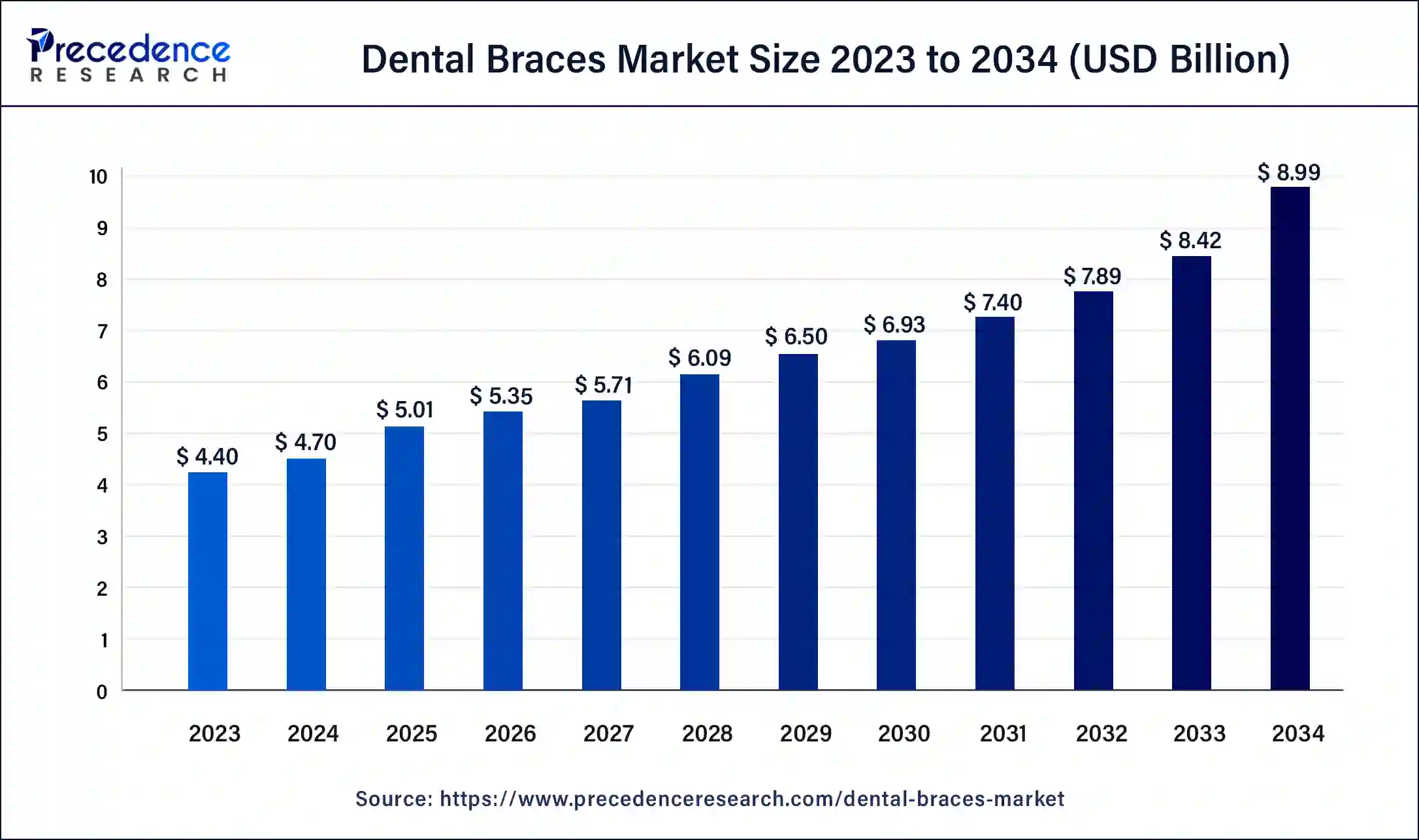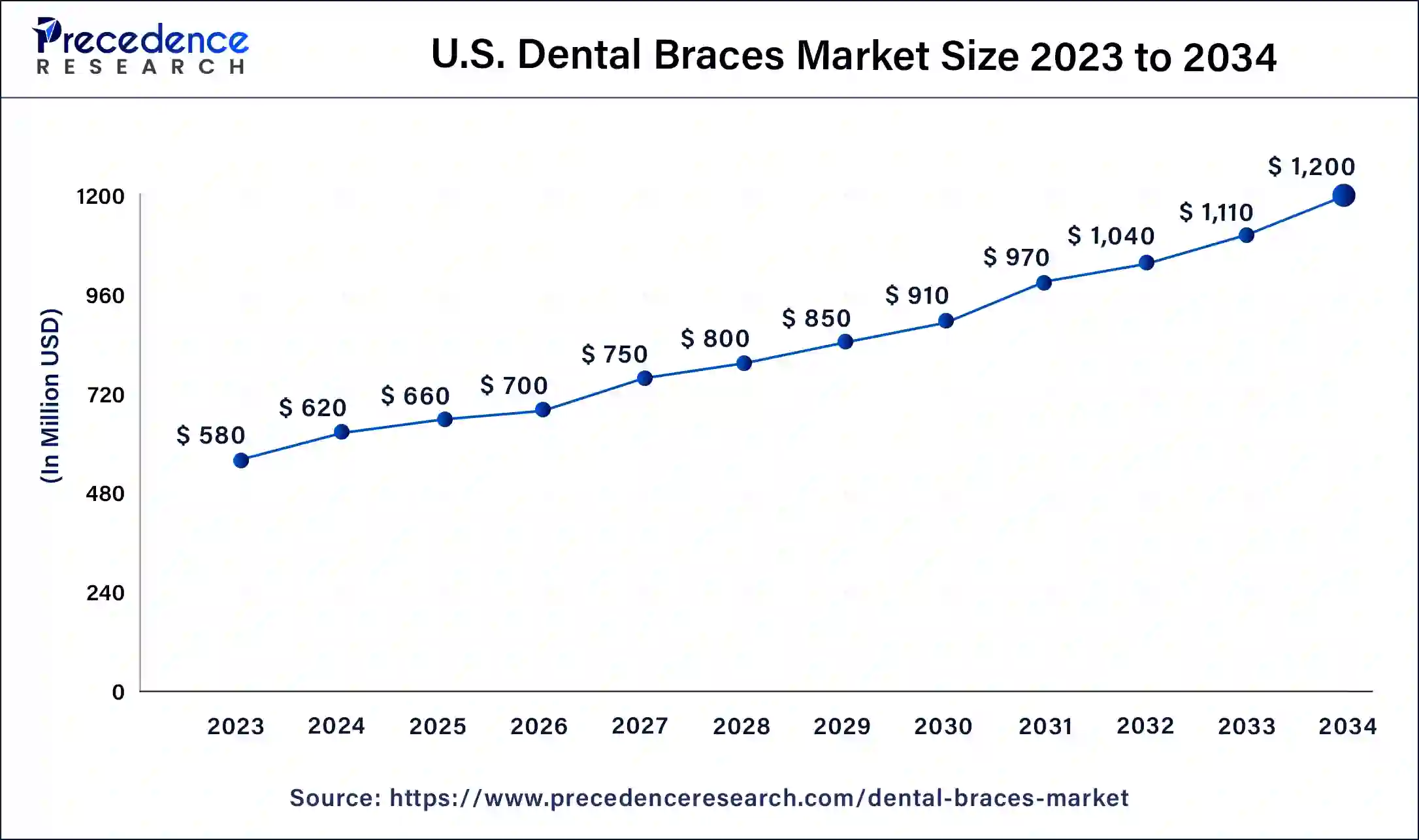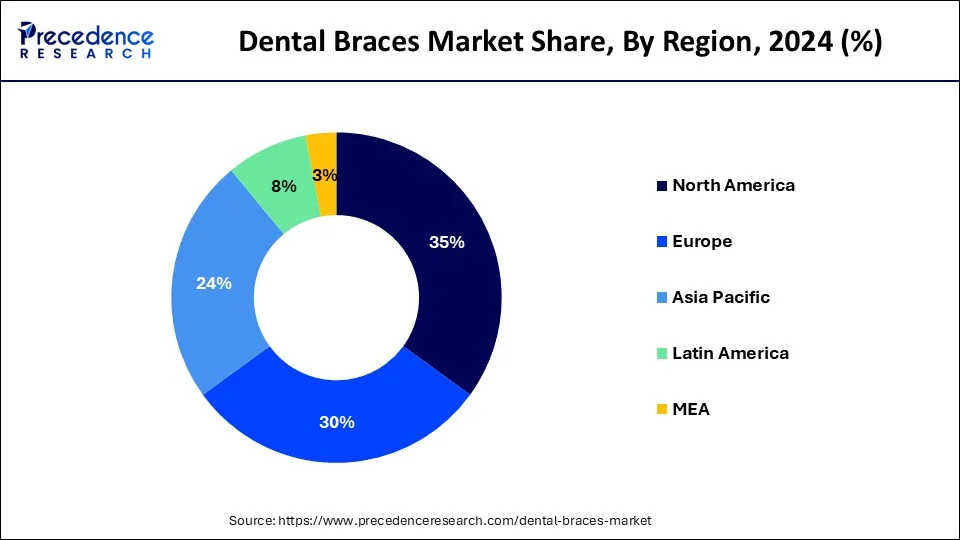January 2025
The global dental braces market size was USD 4.40 billion in 2023, calculated at USD 4.70 billion in 2024 and is expected to be worth around USD 8.99 billion by 2034. The market is slated to expand at 6.71% CAGR from 2024 to 2034.
The global dental braces market size is worth around USD 4.70 billion in 2024 and is anticipated to reach around USD 8.99 billion by 2034, growing at a CAGR of 6.71% over the forecast period 2024 to 2034. The North America dental braces market size reached USD 770 million in 2023. The dental braces market is driven by the increasing demand for aesthetic dental treatments. Integration of 3D printing, digital scans, and AI for customized braces is making treatments more precise, efficient, and attractive to patients.

The U.S. dental braces market size was exhibited at USD 580 million in 2023 and is projected to be worth around USD 1,200 million by 2034, poised to grow at a CAGR of 6.83% from 2024 to 2034.

North America dominated the dental braces market in 2023. North America is considered a well-established healthcare system with numerous accesses to dental care, which enables a higher rate of orthodontic consultations and treatments. For instance, innovations in 3D printing and digital imaging have improved the customization and effectiveness of orthodontic therapies, giving patients satisfaction and results. Top leading key players engage in strategic partnerships with dental clinics and practitioners to establish their products which will expand the market.

Asia-Pacific is observed to be the fastest growing in the dental braces market during the forecast period. The population of Asia- Pacific has a growing awareness of oral health and aesthetics which is heading towards a higher need for orthodontic treatments, including braces. Adopting digital technology in orthodontics, such as computer-aided design (CAD) and 3D imaging, improves treatment planning and patient outcomes, which encourages more patients to seek treatment. Major international key players are expanding their regional presence which eventually increases competition and innovation in product offerings.
The dental braces industry is involved in the designing, manufacturing, and distributing of orthodontic devices used to align and straighten teeth. With an increasing need towards appearance and dental aesthetics, more people are drawn towards orthodontic treatments. Increasing awareness of dental health and the significance of orthodontic care have led to more individuals seeking braces at younger ages. Beyond aesthetics, braces are used to correct dental issues such as malocclusion, improper bites, and crowding, which is heading towards better oral health and even reducing the risk of dental problems in future.
How is AI Helping the Dental Industry?
Artificial Intelligence (AI) has brought a revolutionary change in different industries and of which orthodontics is no exception. Integrating AI into orthodontic treatment planning is transforming how orthodontists approach patient care by offering undoubted precision, efficiency, and personalization. There is one significant advantage of AI in orthodontics is it can create highly personalized treatment plans such as by analyzing individual patient data, which has a dental history, facial structure, and specific orthodontic needs, AI helps in creating a treatment particularly for individual rather than everyone. It analyzes historical data and patterns; AI can also predict how a patient’s teeth will move during treatment and anticipate potential challenges. This predictive capability allows orthodontists to proactively address issues before they arise, resulting in smoother, and successful treatment.
| Report Coverage | Details |
| Market Size by 2034 | USD 8.99 Billion |
| Market Size in 2024 | USD 4.70 Billion |
| Market Growth Rate from 2024 to 2034 | CAGR of 6.71% |
| Largest Market | North America |
| Base Year | 2023 |
| Forecast Period | 2024 to 2034 |
| Segments Covered | Material, Position, Product Type, End-use, and Regions |
| Regions Covered | North America, Europe, Asia-Pacific, Latin America and Middle East & Africa |
Increasing number of dental practitioners in developed countries
As dental practitioners have increased, more patients have got access to orthodontic services. This availability allows patients to receive the correct time assessments and treatments for dental misalignments, which has raised the demand for dental braces. More dental practitioners are directly proportional to more focus on personalized treatment plans. This customization improves patient satisfaction and improves the likelihood that patients will pursue orthodontic solutions.
High costs of dental braces and procedures
As many dental insurance plans have very limited coverage for orthodontic treatments. Even with coverage, patients often face trouble due to high prices, leading to limits to pursuing treatment. In times of economic downturn, patients may postpone or cancel orthodontic treatments, directly hindering the market growth. Emergence of companies offering low-cost, direct-to-consumer orthodontic solutions such as clear aligners challenge traditional orthodontic practices, which makes it essential for these practices to justify their higher prices through enhanced services or results.
Growing demand for aesthetic solutions
As customers are educated and show concerns about their appearance, there is an increasing need for aesthetic dental solutions. Moreover, the traditional metal braces are generally considered unattractive, prompting demand for more discreet options such as clear aligners. There is a growing focus on overall health and wellness, which includes oral health mostly inspired by influencers and celebrities. Aesthetic braces improve appearance and oral hygiene and alignment, aligning with this trend toward holistic well-being.
The ceramic braces segment dominated the dental braces market in 2023. Ceramic braces are prepared from translucent materials, which makes them less visible, which mainly appeals to adults and teenagers who choose a more discreet orthodontic solution. The ceramic material has a smooth finish, which minimizes discomfort and irritation to the gums and cheeks compared to metal brackets. Ceramic braces are considered effective braces in correcting dental issues that include misaligned teeth, and bite problems. Its effectiveness has made them popular among patients seeking aesthetic options without compromising results.
The metal braces segment shows a significant growth in the dental braces market during the forecast period. The metal braces are more cost-effective than orthodontic options such as ceramic or lingual braces which makes them used by a wider population which involves those who may not have insurance coverage for treatments. Users are increasingly educated about the significance of oral health and orthodontic treatment. Metal braces are known as a traditional and widely recognized option that attracts a significant portion of this population.
The external braces segment dominated the dental braces market in 2023. External braces are mainly traditional metal braces which are well-known and have a long history of effectiveness in correcting dental misalignments. It is visibility often reassures patients and parents of their efficacy. Dentists and orthodontists mostly recommend external braces due to their proven results and ability to address various dental alignment issues. Many orthodontic patients are children and teenagers who often prefer traditional external braces due to their popularity in peer groups and schools.
The bracket segment dominated the dental braces market in 2023. As awareness of dental aesthetics grows, more patients seek orthodontic treatment. Brackets are a crucial part of traditional braces, metal brackets are often less expensive than clear aligners or other orthodontic devices which appeal to a wider range of patients, making them a preferred choice. Many orthodontists choose to use brackets due to their effectiveness and reliability.
The arch wire segment shows a notable growth in the dental braces market during the forecast period. The aesthetic considerations play a vital role in driving the need for braces, mostly in adults and adolescents and as more people prioritize their appearance, the demand for effective orthodontic solutions grows, raising the demand for arch wires. Moreover, as patients become more informed about their dental health options, they are more likely to pursue orthodontic treatment. Further, driving the need for arch wires as integral base of braces.
The children segment shows significant growth in the dental braces market during the forecast period. The growing awareness among parents about the significance of oral health has raised to an increased need for dental care for children. The educational campaigns by dental associations brief about early intervention, encouraging parents to seek orthodontic consultations for their children. The children are becoming more aware of their appearance, there is a desire to achieve a perfect smile increases which is contributing to the growth of dental braces. Introduction of aligners particularly for younger patients, such as Invisalign Teen, caters to a region increasingly concerned with aesthetics.
Segments Covered in the Report
By Material
By Position
By Product Type
By End-use
By Geography
For inquiries regarding discounts, bulk purchases, or customization requests, please contact us at sales@precedenceresearch.com
No cookie-cutter, only authentic analysis – take the 1st step to become a Precedence Research client
January 2025
May 2024
October 2023
October 2023